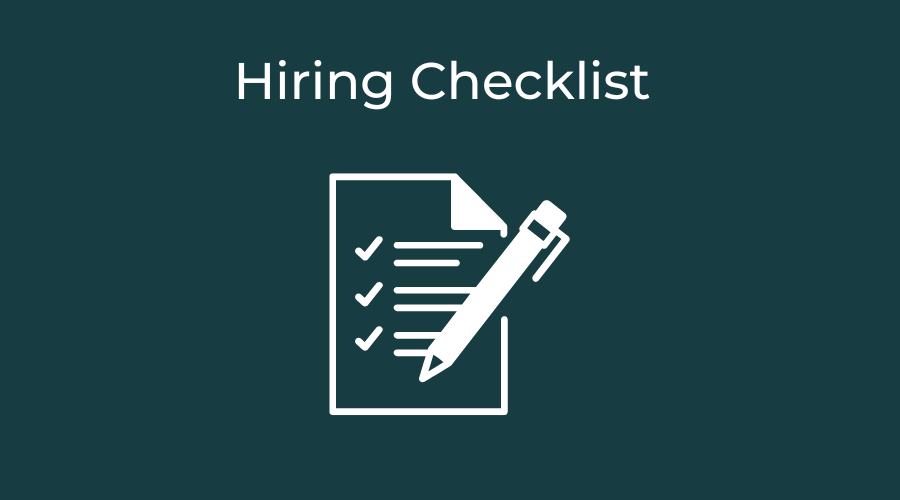
Hiring an Employee Checklist
Hiring a new employee can be a time-consuming and challenging process, but many times employers fail to do it correctly. Job seekers are already stressed about the hoops they have to jump through so give your hiring process a fresh look.
The hiring checklist below is a good way to look at the process and plan at your organization.
- Determine the job requirements: Before you start looking for candidates, you need to have a clear understanding of what the job entails. Make a list of the necessary skills, qualifications, and experience required for the position.
- Create a job description: Based on the job requirements, create a job description that outlines the responsibilities, qualifications, and expectations for the role. Make sure the job description is clear and concise.
- Advertise the job: Once you have a job description, advertise the job through the appropriate channels, such as job boards, social media, or your company’s website. Make sure you include all the necessary details, such as the job title, responsibilities, and required qualifications.
- Review resumes: Once you start receiving resumes, review them carefully to see if the candidates have the required skills and experience. Make a shortlist of the most promising candidates.
- Conduct phone or video interviews: Before inviting candidates for an in-person interview, conduct phone or video interviews to further narrow down your list of candidates. Ask questions about their qualifications, experience, and work history.
- Schedule in-person interviews: Once you have narrowed down your list of candidates, invite them for an in-person interview. Prepare a list of questions in advance to help you assess their skills, experience, and fit with your company’s culture.
- Check references: Before making a job offer, check the candidate’s references to verify their work history and qualifications.
- Make a job offer: If you have identified a candidate who meets your requirements and has the necessary skills and experience, make a job offer. Make sure the offer includes details such as salary, benefits, and start date.
- Conduct a background check: Before the candidate starts working, conduct a background check to ensure they have a clean record and no criminal history.
- Onboard the new employee: Once the candidate has accepted the job offer, start the onboarding process to help them get acclimated to the company and their new role.
That’s the checklist most employers follow but lets dive a little deeper into a few of the more crucial components of it.
Onboarding is the process of integrating a new employee into your company and ensuring that they have the necessary knowledge and tools to be successful in their new role. It’s important to make sure that new employees feel welcome and valued, and that they have the support they need to be productive from day one. Sometime I think employers overlook this aspect which could lead to a bad firs impression with your new hire.
Here are some tips for successful onboarding:
- Start early: Onboarding should start before the new employee’s first day. Send them a welcome email, provide them with an employee handbook, and let them know what to expect on their first day.
- Assign a mentor: Assign a mentor or buddy to the new employee to help them navigate the company culture and answer any questions they may have.
- Provide training: Provide the new employee with the necessary training to perform their job effectively. This may include software training, safety training, or other job-specific training.
- Set clear expectations: Set clear expectations for the new employee’s performance, including goals, timelines, and metrics for success.
- Check in regularly: Check in with the new employee regularly during their first few weeks to make sure they are adjusting well and have everything they need.
Determining the job requirements is another critical step in the hiring process. It’s important to have a clear understanding of what the job entails and what skills and qualifications are necessary for success in the role. The hiring manager and recruiter need to be on the same page here.
Get them together and do this:
- Define the job: Start by defining the job and identifying the core responsibilities and duties. This will help you determine what skills and qualifications are necessary.
- Consider the company culture: Consider the company culture and the type of person who will fit well within the company. For example, if your company values collaboration and teamwork, you may want to prioritize candidates who have demonstrated those skills.
- Look at similar job postings: Look at similar job postings to see what skills and qualifications are typically required for similar roles.
- Consult with colleagues: Consult with colleagues who are familiar with the job to get their input on the necessary skills and qualifications.
- Create a detailed job ad that sells: Use the information you’ve gathered to create a detailed job advertisement that outlines the necessary skills, qualifications, and experience required for the role. This will help you attract the right candidates and ensure that you are evaluating candidates fairly and objectively.
The hiring process needs to be looked at holistically from start to finish. Sometimes I think TA leaders pay too much lip service when it comes to this workflow. Listen to your recruiters and HR people on the front lines and involve them from the beginning to refine and enhance your hiring checklist.


